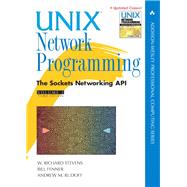
Note: Supplemental materials are not guaranteed with Rental or Used book purchases.
Purchase Benefits
What is included with this book?
| Foreword | p. xvii |
| Preface | p. xix |
| Introduction and TCP/IP | p. 1 |
| Introduction | p. 3 |
| The Transport Layer: TCP, UDP, and SCTP | p. 31 |
| Elementary Sockets | p. 65 |
| Sockets Introduction | p. 67 |
| Elementary TCP Sockets | p. 95 |
| TCP Client/Server Example | p. 121 |
| I/O Multiplexing: The select and poll Functions | p. 153 |
| Socket Options | p. 191 |
| Elementary UDP Sockets | p. 239 |
| Elementary SCTP Sockets | p. 267 |
| SCTP Client/Server Example | p. 287 |
| Name and Address Conversions | p. 303 |
| Advanced Sockets | p. 351 |
| IPv4 and IPv6 Interoperability | p. 353 |
| Daemon Processes and the inetd Superserver | p. 363 |
| Advanced I/O Functions | p. 381 |
| Unix Domain Protocols | p. 411 |
| Nonblocking I/O | p. 435 |
| ioctl Operations | p. 465 |
| Routing Sockets | p. 485 |
| Key Management Sockets | p. 511 |
| Broadcasting | p. 529 |
| Multicasting | p. 549 |
| Advanced UDP Sockets | p. 587 |
| Advanced SCTP Sockets | p. 621 |
| Out-of-Band Data | p. 645 |
| Signal-Driven I/O | p. 663 |
| Threads | p. 675 |
| IP Options | p. 709 |
| Raw Sockets | p. 735 |
| Datalink Access | p. 787 |
| Client/Server Design Alternatives | p. 817 |
| Streams | p. 851 |
| IPv4, IPv6, ICMPv4, and ICMPv6 | p. 869 |
| Introduction | p. 869 |
| IPv4 Header | p. 869 |
| IPv6 Header | p. 871 |
| IPv4 Addresses | p. 874 |
| IPv6 Addresses | p. 877 |
| Internet Control Message Protocols (ICMPv4 and ICMPv6) | p. 882 |
| Virtual Networks | p. 885 |
| Introduction | p. 885 |
| The MBone | p. 885 |
| The 6bone | p. 887 |
| IPv6 Transition: 6to4 | p. 889 |
| Debugging Techniques | p. 891 |
| System Call Tracing | p. 891 |
| Standard Internet Services | p. 893 |
| sock Program | p. 893 |
| Small Test Programs | p. 896 |
| tcpdum Program | p. 896 |
| netstat Program | p. 896 |
| lsof Program | p. 897 |
| Miscellaneous Source Code | p. 899 |
| unp.h Header | p. 899 |
| config.h Header | p. 904 |
| Standard Error Functions | p. 910 |
| Solutions to Selected Exercises | p. 913 |
| Bibliography | p. 947 |
| Index | p. 955 |
| Table of Contents provided by Ingram. All Rights Reserved. |
The New copy of this book will include any supplemental materials advertised. Please check the title of the book to determine if it should include any access cards, study guides, lab manuals, CDs, etc.
The Used, Rental and eBook copies of this book are not guaranteed to include any supplemental materials. Typically, only the book itself is included. This is true even if the title states it includes any access cards, study guides, lab manuals, CDs, etc.